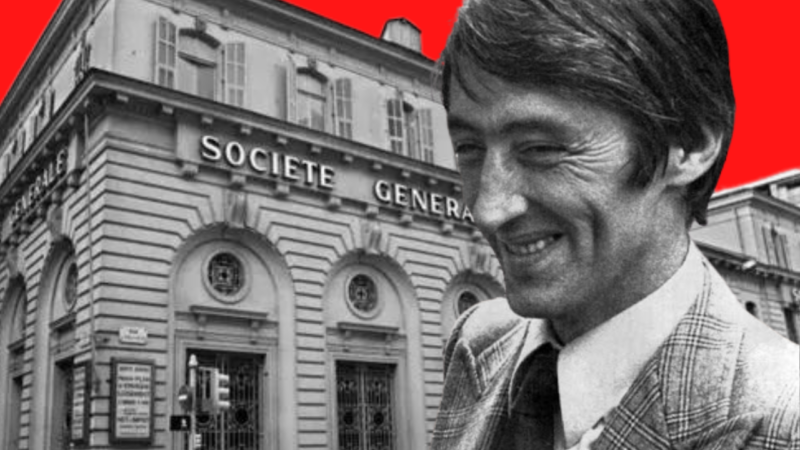Some criminals are famous for their bold heists. Their stories show detailed planning and daring moves. These heists were not just about stealing valuables but involved clever strategies and high-risk actions.
The burglars behind these crimes have left a lasting mark on history, turning their criminal acts into legendary tales.
Here are the most notorious burglars and the famous heists that made them infamous.
Key Takeaways
- These famous heists are known for their bold moves and clever planning, often involving large sums of money or valuable items.
- Criminals like Albert Spaggiari, Jesse James, Bill Mason, and Vincenzo Peruggia have become legends due to their daring crimes.
- Their stories highlight the incredible lengths to which these burglars went, turning their crimes into legendary tales.
Albert Spaggiari – Société Générale Bank Heist

| Heist | Société Générale Bank Heist |
|---|---|
| Location | Nice, France |
| Date | July 16, 1976 |
| Amount Stolen | 60 million francs |
| Method | Tunneling from sewers to vault |
| Key Figure | Albert Spaggiari |
| Outcome | Spaggiari escaped from custody, lived on the run |
Albert Spaggiari masterminded the Société Générale bank heist, one of the most famous bank robberies in history. In July 1976, Spaggiari and his handpicked team of experienced thieves broke into the bank’s vault by tunneling through the sewers. They spent months planning and executing this intricate heist, which culminated in the theft of 60 million francs.
The gang took advantage of the Bastille Day celebrations to cover the noise and activity of their break-in. In a twist that added to the heist’s legend, they reportedly had a picnic inside the vault while emptying the safety deposit boxes. Despite the extensive security measures, the team managed to evade immediate capture.
Albert Spaggiari was eventually arrested but made a daring escape during his trial. He distracted the judge with a coded document, jumped out of a window, and fled on a waiting motorcycle. He lived the rest of his life on the run, probably in Argentina, and underwent plastic surgery to avoid detection. His story remains a fascinating chapter in the annals of criminal history.
Jesse James – Bank and Train Robberies
| Heist | Bank and Train Robberies |
|---|---|
| Location | American Midwest |
| Date | 1866-1882 |
| Amount Stolen | Varied, multiple heists |
| Method | Armed robbery |
| Key Figure | Jesse James |
| Outcome | Killed by a gang member in 1882 |
Jesse James, along with his brother Frank, became infamous for their series of bank and train robberies across the American Midwest. Starting their criminal career as teenagers, the James brothers initially robbed small stores before moving on to more lucrative targets like banks and trains. They formed the James-Younger Gang, which included other notorious outlaws of the time.
The gang’s first major heist was the robbery of the Clay County Savings Association in Liberty, Missouri, in 1866. This was followed by a string of robberies that spread fear throughout the region. They were known for their ruthless methods and ability to evade capture, often using their knowledge of local geography to their advantage.
Jesse James’s criminal exploits were romanticized in books and newspapers, turning him into a folk hero for some, despite his violent methods. The law finally caught up with him in 1882 when Robert Ford, a member of his own gang, shot him in the back to collect a bounty. Jesse James’s death marked the end of an era, but his legend lived on, cementing his place in American folklore.
Bill Mason – High-Profile Jewelry Heists

| Heist | High-Profile Jewelry Heists |
|---|---|
| Location | Various locations in the USA |
| Date | 1970s-1980s |
| Amount Stolen | Approximately $35 million |
| Method | Attending social events and stealing from high-profile individuals |
| Key Figure | Bill Mason |
| Outcome | Served a few years in prison, and later wrote a memoir |
ill Mason became notorious for his series of high-profile jewelry heists across the United States. Starting in the 1970s, Mason targeted wealthy and famous individuals, including celebrities like Truman Capote, Phyllis Diller, and Armand Hammer. He attended social events, blending in with high society, and then used his charm and skills to steal valuable items.
Mason’s heists were meticulously planned, and his ability to gain access to high-security areas made him one of the most successful jewel thieves of his time. Over his career, he stole approximately $35 million worth of jewelry.
Despite his extensive criminal activities, Mason was only caught and served a few years in prison. He later details his exploits in his memoir, “Confessions of a Master Jewel Thief,” where he describes not only his heists but also his decision to return an Olympic gold medal he had stolen from Johnny Weissmuller out of guilt. His story provides a fascinating insight into the life of a master thief and his remarkable ability to evade capture for so long.
Vincenzo Peruggia – The Mona Lisa Theft

| Heist | The Mona Lisa Theft |
|---|---|
| Location | The Louvre, Paris, France |
| Date | August 21, 1911 |
| Amount Stolen | The Mona Lisa painting |
| Method | Hid in the museum overnight and took the painting |
| Key Figure | Vincenzo Peruggia |
| Outcome | Caught attempting to sell the painting, served one year in prison |
Vincenzo Peruggia is best known for stealing one of the most famous paintings in the world, the Mona Lisa, from the Louvre in Paris. On August 21, 1911, Peruggia, who was employed at the museum, hid inside overnight. The next day, he simply took the painting off the wall, concealed it under his clothes, and walked out of the museum.
Peruggia’s motive was to return the painting to Italy, believing that it rightfully belonged there. He kept the Mona Lisa hidden in his apartment for over two years. In 1913, he attempted to sell the painting to an art dealer in Florence, Italy, who recognized it and alerted the authorities. Peruggia was arrested and sentenced to one year in prison.
Despite his crime, Peruggia was hailed as a patriot in Italy. His theft of the Mona Lisa remains one of the most famous art heists in history, and it significantly boosted the painting’s fame and value.
The Northern Bank Robbery
| Heist | The Northern Bank Robbery |
|---|---|
| Location | Belfast, Northern Ireland |
| Date | December 20, 2004 |
| Amount Stolen | £26.5 million |
| Method | Kidnapping bank managers and their families |
| Key Figures | Unidentified gang |
| Outcome | Only one arrest for money laundering, the case remains unsolved |
The Northern Bank Robbery is one of the most infamous heists in history, both for its audacity and for the amount stolen. On December 20, 2004, a gang of thieves executed a meticulously planned operation in Belfast, Northern Ireland. They disguised themselves as police officers and kidnapped two bank managers and their families, holding them hostage overnight.
The following day, the bank managers were forced to continue with their workday as usual, with their families’ lives at stake. After the bank closed, the managers let the thieves into the vault, where they loaded £26.5 million into their vehicles. The gang escaped without immediate detection.
Despite extensive investigations, the case remains largely unsolved. Only one person has been arrested in connection with the heist, for money laundering. The Northern Bank Robbery remains the largest bank robbery in Irish history, leaving many questions unanswered about the identities of the perpetrators and the fate of the stolen money.
The Securitas Depot Heist
| Heist | The Securitas Depot Heist |
|---|---|
| Location | Tonbridge, Kent, England |
| Date | February 22, 2006 |
| Amount Stolen | £53 million |
| Method | Kidnapping and impersonation of police officers |
| Key Figures | Gang of at least six men |
| Outcome | Multiple arrests, large portion of the money unrecovered |
The Securitas Depot Heist remains the largest cash robbery in British history. On the night of February 22, 2006, a gang of at least six men carried out a meticulously planned heist at the Securitas cash depot in Tonbridge, Kent. The robbers kidnapped the depot manager and his family, posing as police officers to gain their cooperation.
They took the manager to the depot, where they bound and gagged 14 staff members. The gang then loaded £53 million in cash into a lorry, leaving behind an additional £154 million due to lack of space. The heist was executed with military precision, and the hostages were left locked in metal cages.
The police launched an extensive investigation, resulting in multiple arrests. Despite this, a large portion of the stolen money was never recovered. The heist’s scale and the gang’s audacity made it one of the most shocking crimes in recent history.
The Central Bank of Iraq Robbery

| Heist | The Central Bank of Iraq Robbery |
|---|---|
| Location | Baghdad, Iraq |
| Date | March 18, 2003 |
| Amount Stolen | £575 million (approx. $1 billion) |
| Method | Direct withdrawal using a handwritten note |
| Key Figure | Saddam Hussein and his son Qusay Hussein |
| Outcome | Large portion of the money remains unrecovered |
The Central Bank of Iraq Robbery, executed just before the fall of Baghdad in 2003, is considered the largest bank heist in history. On March 18, 2003, Saddam Hussein ordered the withdrawal of £575 million (approximately $1 billion) from the Central Bank of Iraq. His son, Qusay Hussein, delivered a handwritten note to the bank, demanding the funds to be handed over immediately.
The money, which accounted for a significant portion of Iraq’s reserves, was loaded onto trucks and taken away. This heist occurred amidst the chaos of the Iraq War, and the precise use of the funds remains largely unknown. While some of the money was later recovered, a substantial amount is still missing.
The sheer scale and brazen nature of this robbery, conducted by a country’s leader, make it one of the most remarkable and audacious heists ever.
Last Words
As you can see, these are some incredible stories of huge robberies that were even an inspiration for some movies. You could also learn more about the personalities of those who were behind those famous heists.

